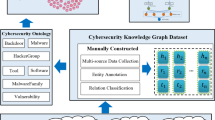Abstract
Network systems are composed of thousands of devices connected in complex network topologies. The diversity and complexity of these devices increase the security risks of network systems. Cyber Threat Intelligence (CTI) contains rich information about devices, cyber, and defenses. However, due to the lack of correlation among security knowledge, some advanced reasoning tasks cannot be performed, such as device attack information and defense strategies. We construct the CTI ontology and knowledge graph, and propose a defense strategy inference model consisting of knowledge graph embedding algorithms CTI-KGE and reasoning rules. CTI-KGE is based on knowledge representation learning, and link prediction tasks can infer the tail entities that have any relationship with the head entity automatically, completing the threat information. Rule reasoning is interpretable, which can generate defense strategies automatically. Finally, we evaluate the effectiveness of the model and demonstrate its feasibility using actual network system scenarios.
Access this chapter
Tax calculation will be finalised at checkout
Purchases are for personal use only
Similar content being viewed by others
References
Burger, E.W., Goodman, M.D., Kampanakis, P., Zhu, K.A.: Taxonomy model for cyber threat intelligence information exchange technologies. In: Proceedings of the 2014 ACM Workshop on Information Sharing & Collaborative Security, pp. 51–60 (2014)
Noel, S., Harley, E., Tam, K.H., Limiero, M., Share, M.: CyGraph: graph-based analytics and visualization for cybersecurity. Handbook Statist. 35, 117–167 (2016)
Cui, B.: Electric device abnormal detection based on IoT and knowledge graph. In: 2019 IEEE International Conference on Energy Internet, pp. 217–220. IEEE, Nanjing, China (2019)
Han, Z., Li, X., Liu, H., Xing, Z., Feng, Z.: Deepweak: Reasoning common software weaknesses via knowledge graph embedding. In: 2018 IEEE 25th International Conference on Software Analysis, Evolution and Reengineering, pp. 456–466. IEEE. Campobasso, Italy (2018)
You, S., Li, X., Chen, W.: Intelligent Prediction for Device Status Based on IoT Temporal Knowledge Graph. In: 2020 IEEE/CIC International Conference on Communications in China, pp. 560–565. IEEE. Chongqing, China (2020)
Zhu, Z., Jiang, R., Jia, Y., Xu, J., Li, A.: Cyber security knowledge graph based cyber attack attribution framework for space-ground integration information network. In: 2018 IEEE 18th International Conference on Communication Technology, pp. 870–874. IEEE. Chongqing, China (2018)
Chen, X., Shen, W., Yang, G.: Automatic Generation of Attack Strategy for Multiple Vulnerabilities Based on Domain Knowledge Graph. In: IECON 2021–47th Annual Conference of the IEEE Industrial Electronics Society, pp. 1–6. IEEE. Toronto, ON, Canada (2021)
Y u, S., Liu, M., Dou, W., Liu, X., Zhou, S.: Networking for big data: a survey. IEEE Commun.Surv. Tutor. 19(1), 531–549 (2017)
Feng, C., Zhou, B., Zhang, H., et al.: HetNet: a flexible architecture for heterogeneous satelliteterrestrial networks. IEEE Network 31(6), 86–92 (2017)
Du, M., Jiang, J., Jiang, Z., Lu, Z., Du,: X.: PRTIRG: a knowledge graph for people-readable threat intelligence recommendation. In: International Conference on Knowledge Science. Engineering and Management, pp. 47–59. Springer, Cham (2019)
Sarhan, I., Spruit, M.: Open-cykg: An open cyber threat intelligence knowledge graph. Knowl.-Based Syst. 233, 107524 (2021)
Rastogi, N., Dutta, S., Zaki, M.J., Gittens, A., Aggarwal, C.: Malont: An ontology for malware threat intelligence. In: Wang, G., Ciptadi, A., Ahmadzadeh, A. (eds.) MLHat 2020. CCIS, vol. 1271, pp. 28–44. Springer, Cham (2020). https://doi.org/10.1007/978-3-030-59621-7_2
Rastogi, N., Dutta, S., Christian, R., Zaki, M., Gittens, A., Aggarwal, C.: Information prediction using knowledge graphs for contextual malware threat intelligence. arXiv preprint arXiv:2102.05571 (2021)
Zhang, H., Yin, Y., Zhao, D., Liu, B.: Network security situational awareness model based on threat intelligence. Journal on Communications 42(6), 182–194 (2021)
Wang, W., Zhou, H., Li, K., Zhe, Tu., Liu, F.: Cyber-Attack Behavior Knowledge Graph Based on CAPEC and CWE Towards 6G. In: You, I., Kim, H., Youn, T.-Y., Palmieri, F., Kotenko, I. (eds.) MobiSec 2021. CCIS, vol. 1544, pp. 352–364. Springer, Singapore (2022). https://doi.org/10.1007/978-981-16-9576-6_24
Wang, Y., Li, Y., Chen, X., Luo, Y.: Implementing Network Attack Detection with a Novel NSSA Model Based on Knowledge Graphs. In: 2020 IEEE 19th International Conference on Trust, Security and Privacy in: Computing and Communications, pp. 1727–1732). IEEE. Guangzhou, China (2020)
Sun, C., Hu, H., Yang, Y., Zhang, H.: Prediction method of 0day attack path based on cyber defense knowledge graph (Chinese). Chinese Journal of Network and Information Security 8(1), 151–166 (2022)
Kiesling, E., Ekelhart, A., Kurniawan, K., Ekaputra, F.: The SEPSES Knowledge Graph: An Integrated Resource for Cybersecurity. In: Ghidini, C., et al. (eds.) ISWC 2019. LNCS, vol. 11779, pp. 198–214. Springer, Cham (2019). https://doi.org/10.1007/978-3-030-30796-7_13
Sahoo, S.S., Halb, W., Hellmann, S. et al.: A survey of current approaches for mapping of relational databases to RDF. W3C RDB2RDF Incubator Group Report, 1, pp. 113–130 (2009)
Chen, X., Jia, S., Xiang, Y.: A review: Knowledge reasoning over knowledge graph. Expert Syst. Appl. 141, 112948 (2020)
Zhang, Z., Cai, J., Zhang, Y., Wang, J.: Learning hierarchy-aware knowledge graph embeddings for link prediction. Proceedings of the AAAI Conference on Artificial Intelligence 34(03), 3065–3072 (2020)
Sun, Z., Deng, Z. H., Nie, J. Y., Tang, J.: Rotate: Knowledge graph embedding by relational rotation in complex space. arXiv preprint arXiv:1902.10197 (2019)
Author information
Authors and Affiliations
Corresponding author
Editor information
Editors and Affiliations
Rights and permissions
Copyright information
© 2023 The Author(s), under exclusive license to Springer Nature Singapore Pte Ltd.
About this paper
Cite this paper
Zhang, S., Li, S., Chen, P., Wang, S., Zhao, C. (2023). Generating Network Security Defense Strategy Based on Cyber Threat Intelligence Knowledge Graph. In: Quan, W. (eds) Emerging Networking Architecture and Technologies. ICENAT 2022. Communications in Computer and Information Science, vol 1696. Springer, Singapore. https://doi.org/10.1007/978-981-19-9697-9_41
Download citation
DOI: https://doi.org/10.1007/978-981-19-9697-9_41
Published:
Publisher Name: Springer, Singapore
Print ISBN: 978-981-19-9696-2
Online ISBN: 978-981-19-9697-9
eBook Packages: Computer ScienceComputer Science (R0)




